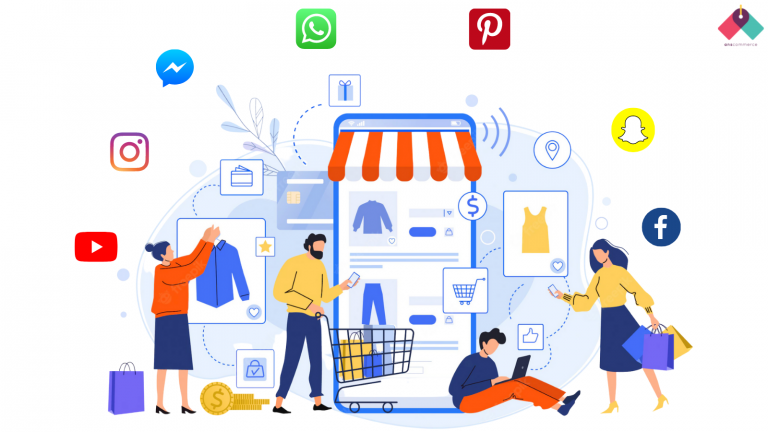
Maximizing E-Commerce Sales Through Social Commerce: A Complete Guide
Introduction: The Rise of Social Commerce
In recent years, the lines between social media and e-commerce have blurred as brands and retailers increasingly use social platforms to sell their products. This fusion is known as social commerce, a strategy where businesses use social media platforms to promote, sell, and engage with customers. The beauty of social commerce is its ability to merge the shopping experience with social interaction, which can lead to increased sales, customer loyalty, and a more personalized shopping journey. According to research, social commerce is projected to reach $2.9 trillion by 2026, indicating its importance in the future of retail and e-commerce. Social media giants like Instagram, Facebook, TikTok, and Pinterest have introduced features specifically designed for shopping, making it easier for users to purchase without leaving their social platform. This streamlined approach provides a frictionless shopping experience, contributing to higher conversion rates and sales.
What is Social Commerce?
Social commerce involves selling products directly through social media platforms. Rather than redirecting users to an external website or e-commerce platform, social commerce allows users to discover, browse, and purchase products without leaving the social media app. This is typically achieved through features like shoppable posts, live-stream shopping, in-app stores, and personalized ads. Social commerce benefits from the highly visual, interactive, and community-driven nature of social media. Customers can engage with products through likes, comments, shares, and user-generated content (UGC), which creates social proof and enhances brand trust.
For businesses, social commerce offers a unique opportunity to connect with customers on platforms they already use daily. By embedding shopping features within social media, brands can shorten the customer journey, increase impulse buys, and use social media data to personalize the shopping experience.
Benefits of Social Commerce for E-Commerce Brands
- Shortened Sales Funnel: Social commerce removes the need for users to leave the social media platform to make a purchase. With features like “Buy Now” buttons and in-app checkout, the sales funnel becomes shorter, reducing friction and making it easier for users to complete purchases. This ease of use can significantly improve conversion rates.
- Increased Engagement: Social commerce thrives on interaction. When users see their friends or influencers endorsing products or posting about their experiences, it encourages engagement. Likes, shares, and comments on product posts increase visibility and brand awareness, creating a more immersive shopping experience.
- Personalization: Social platforms collect vast amounts of user data, which allows brands to target customers with personalized ads and offers. This level of targeting ensures that users see relevant products based on their preferences, increasing the chances of conversion. Platforms like Facebook and Instagram use algorithms that help suggest products that align with users’ past behavior, making the shopping experience feel personalized and tailored.
- Community Building: Social media is inherently community-driven, and social commerce taps into that power. By creating a community around your brand, you can foster deeper relationships with your customers, encourage user-generated content (UGC), and build trust through social proof. Encouraging customers to share their purchases, reviews, and experiences boosts credibility and drives additional sales.
- Reduced Abandonment Rates: One of the biggest challenges in e-commerce is shopping cart abandonment. Social commerce helps combat this by keeping the entire shopping experience within a familiar and trusted social platform. By minimizing the steps between product discovery and purchase, businesses reduce the likelihood of losing customers midway through the process.
- Leveraging Influencers: Influencer marketing is a powerful tool in social commerce. When influencers showcase products in real-time, they not only provide social proof but also give their audience a firsthand look at how the product works. Live-stream shopping is particularly effective in this regard, allowing customers to ask questions and purchase in real time.
Best Social Commerce Platforms
Not all social platforms are created equal when it comes to e-commerce. Each platform has its own strengths, features, and user demographics, so choosing the right one for your business is essential. Below are the leading platforms that offer the most potential for social commerce.
1. Instagram: Instagram is one of the leading platforms for social commerce, thanks to its highly visual nature and strong focus on lifestyle content. Instagram has integrated several shopping features, including:
- Shoppable Posts: Businesses can tag products in posts and stories, allowing users to click and purchase directly from their feeds.
- Instagram Shops: A dedicated in-app storefront where users can browse collections, explore products, and make purchases without leaving Instagram.
- Product Stickers in Stories: These stickers allow businesses to showcase individual products in stories with a direct link to purchase.
- Instagram Checkout: Users can complete their purchases directly in the app without being redirected to an external site.
2. Facebook Instagram: Facebook’s vast user base and sophisticated ad targeting capabilities make it a powerhouse for social commerce. Some of Facebook’s key social commerce features include:
- Facebook Shops: A customizable storefront that allows businesses to showcase products on both Facebook and Instagram.
- Facebook Marketplace: A more peer-to-peer shopping experience where individuals and businesses can sell products locally.
- In-App Checkout: Similar to Instagram, Facebook allows users to complete transactions without leaving the app.
- Facebook Live Shopping: Brands can host live-streamed shopping events where viewers can ask questions and purchase in real time.
3. TikTok: TikTok has quickly emerged as a powerful platform for social commerce, especially among younger audiences. Its short-form video content lends itself to creative product showcases, and its algorithm prioritizes engaging content, making it ideal for viral marketing.
- TikTok Shopping: Brands can add shopping tabs to their profiles and create shoppable video content, linking directly to product pages.
- Live-Stream Shopping: Similar to Instagram and Facebook, TikTok allows brands and influencers to host live shopping events where users can purchase products in real time.
- Hashtag Challenges: These are branded challenges that encourage user-generated content, promoting products organically through participation and sharing.
4. Pinterest: Pinterest is a highly visual platform where users often go for inspiration, making it a natural fit for social commerce. Some of its key features include:
- Buyable Pins: Pins that allow users to purchase directly through Pinterest without leaving the app.
- Pinterest Shops: Brands can create a customized storefront and showcase products to Pinterest’s highly engaged audience.
- Visual Search: Pinterest’s unique visual search tool allows users to search for products they see in images, making it easy for users to discover new items.
Strategies for Leveraging Social Commerce to Drive Sales
1. Optimize Your Social Profiles for Shopping: Your social media profiles should be fully optimized for shopping. This means setting up all available shopping features, ensuring your storefront is visually appealing, and that product descriptions are accurate and informative. Key tips for profile optimization include:
- Set Up a Shop: Use the shopping features offered by platforms like Instagram, Facebook, and Pinterest. This will allow you to tag products in posts and make it easy for users to purchase directly from your profile.
- High-Quality Visuals: Invest in professional photography and high-quality product images. Social media is a visual medium, and attractive imagery is critical to capturing attention.
- Complete Product Descriptions: Include detailed product descriptions, sizing information, pricing, and availability. This helps reduce customer friction and ensures they have all the information they need before making a purchase.
2. Create Shoppable Content: Shoppable content refers to social media posts that include product tags or direct links to purchase. It’s important to weave your products naturally into your content rather than being overly promotional. Some types of shoppable content include:
- Lifestyle Images: Showcase your products in real-life scenarios, helping customers visualize how they would use them.
- User-Generated Content: Encourage customers to post pictures or videos of themselves using your products and tag your brand. This adds authenticity and social proof.
- Influencer Partnerships: Work with influencers to create content that promotes your products. Influencers can tag your products in their posts, allowing their followers to purchase directly from the content.
- Reviews and Ratings: Encourage customers to leave reviews and ratings on your social media profiles and product pages.
- User-Generated Content: Share posts from customers who are using and enjoying your products. This can be done through reposting or creating highlight reels of customer content.
- Influencer Endorsements: When influencers post about your products, it acts as a form of social proof. Their followers trust their opinions and are more likely to make a purchase based on their recommendations.
- Host Regular Events: Consistency is key to building an audience for live shopping. Regular events keep customers engaged and give them a reason to return.
- Offer Exclusive Deals: To create a sense of urgency, offer exclusive discounts or promotions that are only available during the live stream.
- Collaborate with Influencers: Partner with influencers or brand ambassadors to host live shopping events. Their followers are likely to tune in and make purchases based on their recommendations.
- Dynamic Product Ads: These ads automatically show relevant products to users based on their past behavior, such as items they’ve viewed or added to their cart but didn’t purchase.
- Lookalike Audiences: Create lookalike audiences to target users who share characteristics with your existing customers.
- Retargeting Ads: Use retargeting ads to re-engage users who have interacted with your brand but haven’t made a purchase. This is especially effective for reducing cart abandonment.
UGC not only builds trust with potential customers but also increases the likelihood of your products being shared, expanding your reach organically.
Measuring Success: Key Metrics for Social Commerce
To ensure your social commerce efforts are driving results, it’s essential to track key metrics. Some important metrics to monitor include:
- Engagement Rate: The number of likes, comments, shares, and interactions your posts receive. Higher engagement typically leads to better visibility and sales.
- Conversion Rate: The percentage of users who make a purchase after interacting with your social commerce posts or ads.
- Average Order Value (AOV): The average amount spent per transaction. A higher AOV indicates that customers are purchasing more or choosing higher-priced items.
- Return on Ad Spend (ROAS): The revenue generated for every dollar spent on social media advertising. A high ROAS indicates that your ads are effective at driving sales.
- Click-Through Rate (CTR): The percentage of users who click on your shoppable posts or ads. This shows how compelling your content is at encouraging users to explore your products.
Conclusion
Social commerce is an evolving and essential part of modern e-commerce strategies. By integrating shopping directly into social platforms, businesses can shorten the customer journey, enhance engagement, and drive more sales. From optimizing your profiles and creating shoppable content to leveraging live shopping and social proof, the opportunities for boosting e-commerce sales through social commerce are immense. To succeed in social commerce, businesses must choose the right platforms, create engaging and authentic content, and consistently measure performance. By following the strategies outlined in this guide, you can build a successful social commerce strategy that maximizes your e-commerce sales in the ever-growing digital marketplace.

Leave a Comment